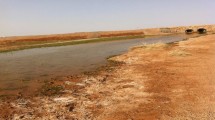Abstract
Freshwater is the main natural resource used for various forms of activities in our daily routines such as drinking, as well as for various developmental uses. Increasing the degree of contamination leads to disruption of our natural world which harms both the physical environments and the living organisms existing in the ecosystem. In the present paper, we studied water source samples taken from six spring water wells (Bas Cheliff Oued-Rhiou, Jdiouia, H'madna) located in rural areas of the Wilaya of Relizane, Algeria in the duration between January and December 2018. In accordance with the Algerian Bureau of Standards (IANOR) and the adopted World Health Organization (WHO), optimal guidelines for drinking water are tested, matched and validated for the characteristics of physical criteria and the bacterial load received. In addition, supplies of water have been tested for selected physical and chemical properties including temperature, acidity (pH), electrical conductivity (EC), ammonium, potassium, nitrate, phosphate, sulfate, copper concentration, and bacteriological well analyses for fecal bacillus contamination. The obtained results show that the mean parameter EC (526.25 μc/cm and 1293.92 μc/cm) was not substantially different because of the high concentration of total solids dissolved in water due to fertilizers dissolved used in agriculture. Insignificant variations of pH were found(6 < pH < 8.5). However, the mean significant values are related to ammonium, potassium, nitrate, phosphate, and copper concentrations. The current study shows that most tropical supplies of water may not meet the standards of IANOR and WHO for drinking water and can therefore be a potential source of waterborne diseases. The pathogenic bacteria were not detected in the study wells.

Source: google earth june2019)










Similar content being viewed by others
References
Abubakar, I., et al. (2018). The UCL–Lancet Commission on Migration and Health: The health of a world on the move. The Lancet, 392(10164), 2606–2654.
Boone, D. R., & Xun, L. (1987). Effects of pH, temperature, and nutrients on propionate degradation by a methanogenic enrichment culture. Applied and Environmental Microbiology, 53(7), 1589–1592.
Butterworth, J., Sutton, S., & Mekonta, L. (2013). Self-supply as a complementary water services delivery model in Ethiopia. Water Alternatives, 6(3), 405.
Delpla, I., et al. (2009). Impacts of climate change on surface water quality in relation to drinking water production. Environment International, 35(8), 1225–1233.
Friedlander, L. R., et al. (2015). ‘The effect of pyrite on Escherichia coli in water: Proof-of-concept for the elimination of waterborne bacteria by reactive minerals. Journal of Water and Health, 13(1), 42–53.
Gadgil, A. (1998). Drinking water in develo** countries. Annual Review of Energy and the Environment, 23(1), 253–286.
Hartani, T., Douaoui, A., & Kuper, M. (2009). Economies d’eau en systèmes irrigués au Maghreb. In Atelier Régional du Projet Sirma (p. 4). CIRAD, Mostaganem.
Iroongor, B. T., & Long-Cang, S. (2007). Water supply crisis and mitigation options in Kisumu city, Kenya. Water Resources Development, 23(3), 485–500.
Khan, M. S., & Ahmad, S. R. (2012). Microbiological contamination in groundwater of Wah area. Pakistan Journal of Science, 64(1), 20–23.
Lukubye, B., & Andama, M. (2017). Bacterial analysis of selected drinking water sources in Mbarara Municipality, Uganda. Journal of Water Resource and Protection, 9(8), 999–1013.
Malek, A., Kahoul, M., & Bouguerra, H. (2019). Groundwater’s physicochemical and bacteriological assessment: Case study of well water in the region of Sedrata, North-East of Algeria. Journal of Water and Land Development, 41(1), 91–100.
Martínez-Santos, P. (2017). Does 91% of the world’s population really have “sustainable access to safe drinking water”? International Journal of Water Resources Development, 33(4), 514–533.
McCasland, M., Trautmann, N. M., & Wagenet, R. J. (1985). Nitrate: Health effects in drinking water. Cornell Cooperative Extension.
Moore, R. B. (2004). Quality of water in the fractured-bedrock aquifer of New Hampshire. US Department of the Interior, US Geological Survey.
Narendra, P., & Sharma, H. (1993). African water resources. World Bank Publications.
Nzunga, S. O., Kiplagat, K., & Paul, O. (2013). Techniques for potable water treatment using appropriate low cost natural materials in the tropics. The Journal of Microbiology, Biotechnology and Food Sciences, 2(5), 2294.
Onda, K., LoBuglio, J., & Bartram, J. (2012). Global access to safe water: Accounting for water quality and the resulting impact on MDG progress . International Journal of Environmental Research and Public Health, 9(3), 880–894.
Parker, A. A., et al. (2006). Sustained high levels of stored drinking water treatment and retention of hand-washing knowledge in rural Kenyan households following a clinic-based intervention. Epidemiology & Infection, 134(5), 1029–1036.
Pedley, S., & Howard, G. (1997). The public health implication of groundwater microbiology. Quarterly Journal of Engineering Geology, 30(2), 179–188.
Redouane, F., & Mourad, L. (2016). Pollution characterization of liquid waste of the factory complex Fertial (Arzew, Algeria). Journal of the Air & Waste Management Association, 66(3), 260–266.
Reid, D. C., et al. (2003). The quality of drinking water from private water supplies in Aberdeenshire, UK. Water Research, 37(2), 245–254.
Rodier, J., & Legube, B. (2009). L’analyse de l’eau. Dunod.
Shyamala, R., Shanthi, M., & Lalitha, P. (2008). Physicochemical analysis of borewell water samples of Telungupalayam area in Coimbatore District, Tamilnadu, India. Journal of Chemistry, 5(4), 924–929.
WHO, G. (2011). Guidelines for drinking-water quality (Vol. 216, pp. 303–304). Geneva: World Health Organization.
Acknowledgments
The authors wish to thank all who assisted in conducting this work.
Author information
Authors and Affiliations
Corresponding author
Ethics declarations
Conflict of interest
The authors declare that there is no conflict of interest.
Appendix
Appendix
See Table 4.
Rights and permissions
About this article
Cite this article
Fares, R., Naim, H. & Bouadi, A. Groundwater pollution in the region of Relizane, Algeria with focus on the physical–chemical and bacteriological characteristics. Int J Energ Water Res 5, 247–257 (2021). https://doi.org/10.1007/s42108-021-00124-6
Received:
Accepted:
Published:
Issue Date:
DOI: https://doi.org/10.1007/s42108-021-00124-6




